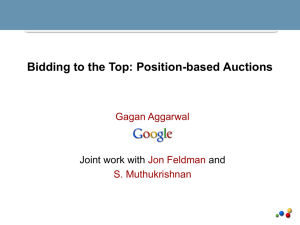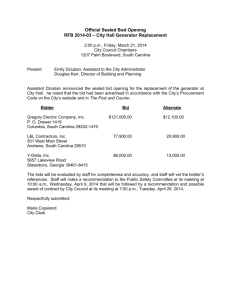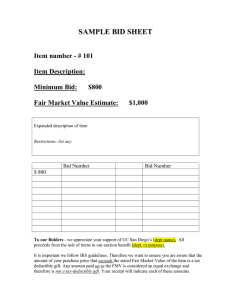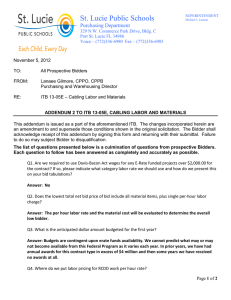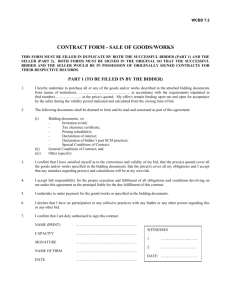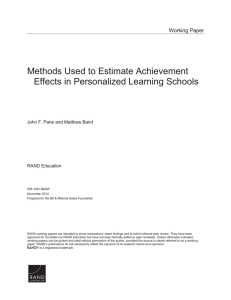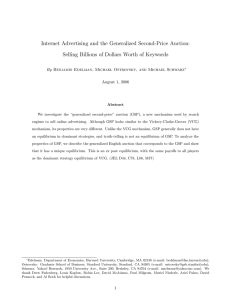Simon Fraser University Fall 2013 Econ 383 (Applied Game Theory) Final Exam
advertisement
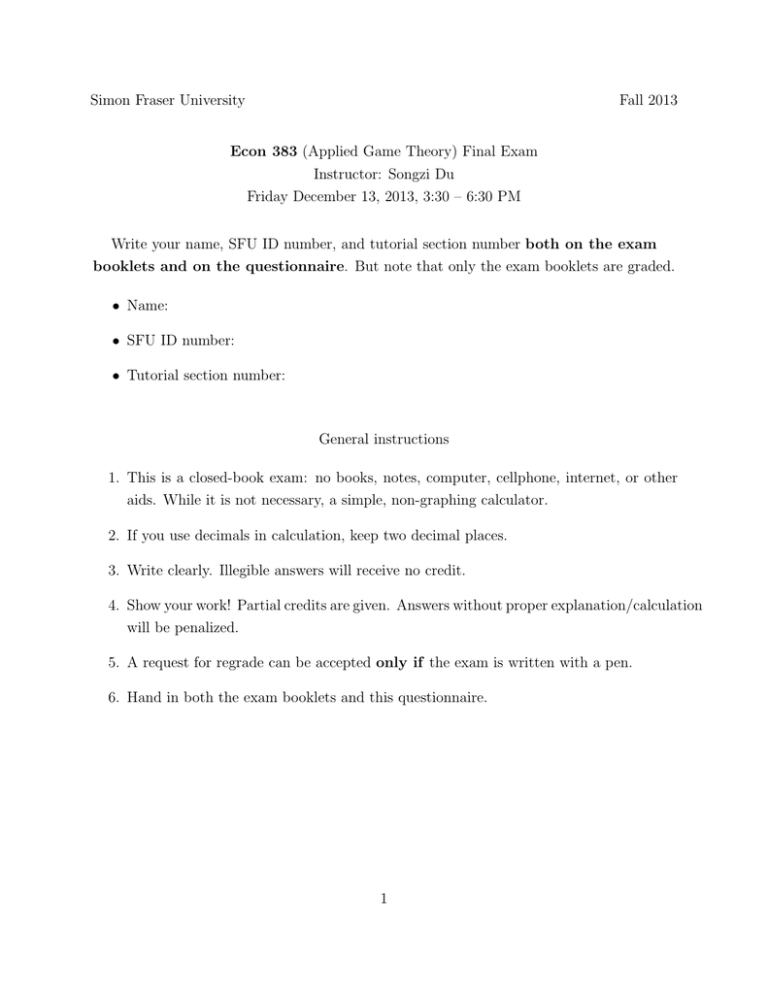
Simon Fraser University
Fall 2013
Econ 383 (Applied Game Theory) Final Exam
Instructor: Songzi Du
Friday December 13, 2013, 3:30 – 6:30 PM
Write your name, SFU ID number, and tutorial section number both on the exam
booklets and on the questionnaire. But note that only the exam booklets are graded.
• Name:
• SFU ID number:
• Tutorial section number:
General instructions
1. This is a closed-book exam: no books, notes, computer, cellphone, internet, or other
aids. While it is not necessary, a simple, non-graphing calculator.
2. If you use decimals in calculation, keep two decimal places.
3. Write clearly. Illegible answers will receive no credit.
4. Show your work! Partial credits are given. Answers without proper explanation/calculation
will be penalized.
5. A request for regrade can be accepted only if the exam is written with a pen.
6. Hand in both the exam booklets and this questionnaire.
1
Write Question 1–2 on booklet #1 and Question 3–4 on booklet #2.
1.
(15 points) There are three roommates who are considering to buy an expresso
machine. The cost of the machine is $200. Each roommate i has a private value vi for the
expresso machine which is his private information. His total payoff, if the machine is bought,
is vi − Pi where Pi is the payment that he makes; his payoff is zero if the machine is not
bought.
Note that the social welfare is v1 + v2 + v3 − 200 if the machine is bought, and is zero if
the machine is not bought.
(i) Derive the VCG mechanism that implements the efficient outcome (i.e., one that maximizes the social welfare).
(ii) Suppose that roommate 2 reports v̂2 = 50, and roommate 3 reports v̂3 = 130 in the
VCG mechanism that you derived. And suppose that v1 = 30. Argue that reporting
v̂1 = v1 = 30 is a best response for roommate 1.
(iii) Repeat (ii) when v̂2 = 30 , v̂3 = 50 and v1 = 100.
(iv) What is the definition of a dominant strategy? Is reporting one’s value truthfully a
dominant strategy in the VCG mechanism? (Answer yes or no.)
2. (25 points) Suppose that there are three advertisers (B = {1, 2, 3}) with values per
click of v1 = 4, v2 = 3 and v3 = 2. There are three ad slots (S = {a, b, c}), with clickthrough rates of ra = 4, rb = 2, and rc = 1. The value of advertiser j ∈ B from slot i ∈ S is
vi,j = ri vj .
(i) There are six possible matchings that assign advertisers to (different) slots. Calculate
the total value (i.e., social welfare) for each of them. What is the optimal (social-welfare
maximizing) matching?
2
1
1
1
1
1
1
–
–
–
–
–
–
Matching
a, 2 – b, 3 – c
a, 2 – c, 3 – b
b, 2 – a, 3 – c
b, 2 – c, 3 – a
c, 2 – a, 3 – b
c, 2 – b, 3 – a
Total value
(ii) Run the bipartite-graph auction on these values. (Consider only integer prices.) For
each step of the auction, write down the current prices and the preferred-seller graph,
and identify the constricted set of advertisers and the over-demanded set of slots. What
are the market-clearing prices and the matching from this auction?
(iii) Consider the VCG mechanism. Calculate the payments that the advertisers make in
the VCG mechanism when they truthfully report their values, and find the matching
that the VCG mechanism implements.
(iv) Now consider the generalized second price auction. Suppose that the values are common
knowledge. Construct a Nash equilibrium, and verify that it is a Nash equilibrium (i.e.,
no one has incentive to deviate). What are the matching and payments given by your
Nash equilibrium?
3. (10 points) Consider the second price auction of a single object and with a reserve
price of R = 2. There are two bidders who have independent private values vi , which are
either 1 or 3. For each bidder i, the probabilities of vi = 1 and vi = 3 are each 1/2. If there
is a tie at a bid of x ≥ R for the highest bid, the winner is selected at random from among
the highest bidders and the price is x. (Recall that if the highest bid is above the reserve
price while the second highest bid is below the reserve price, then the highest bidder is the
winner and pays the reserve price.)
(i) Suppose that the bidder 2 submits a bid of b2 = 1, and v1 = 1. Argue that the best
response of bidder 1 is to bid v1 .
(ii) Suppose that the bidder 2 submits a bid of b2 = 3, and v1 = 1. Argue that the best
response of bidder 1 is to bid v1 .
3
(iii) Suppose that the bidder 2 submits a bid of b2 = 1, and v1 = 3. Argue that the best
response of bidder 1 is to bid v1 .
(iv) Suppose that the bidder 2 submits a bid of b2 = 3, and v1 = 3. Argue that the best
response of bidder 1 is to bid v1 .
(v) Calculate seller’s expected revenue when everyone plays the dominant strategy.
4.
(30 points) There are three advertisers (B = {1, 2, 3}) and three ad slots (S =
{a, b, c}). The advertisers’ values are tabulated below:
Advertiser
1
2
3
value for slot a
4
2
2
value for slot b
3
4
1
value for slot c
3
1
0
Table 1:
Part (i)–(iv) walk you through the working of the VCG mechanism for these values (which
are not multiplicative). Suppose that the advertisers truthfully report their values in the
VCG mechanism.
(i) There are six possible matchings that assign advertisers to (different) slots. Calculate
the total value (i.e., social welfare) for each of them. What is the optimal (social-welfare
maximizing) matching? This is the matching implemented by the VCG mechanism.
1
1
1
1
1
1
–
–
–
–
–
–
Matching
a, 2 – b, 3 – c
a, 2 – c, 3 – b
b, 2 – a, 3 – c
b, 2 – c, 3 – a
c, 2 – a, 3 – b
c, 2 – b, 3 – a
Total value
(ii) Consider advertiser 1. What is the total value of others when advertiser 1 is present in
the VCG mechanism? What is the total value of others when advertiser 1 is not present
in the VCG mechanism? (To answer the second question calculate others’ total value
4
in all matchings without advertiser 1.) Finally, what is the payment that advertiser 1
makes in the VCG mechanism?
Matching
2 – b, 3 – c
2 – c, 3 – b
2 – a, 3 – c
2 – c, 3 – a
2 – a, 3 – b
2 – b, 3 – a
Total value without advertiser 1
(iii) Repeat (ii) for advertiser 2.
Matching
1 – a, 3 – c
1 – a, 3 – b
1 – b, 3 – c
1 – b, 3 – a
1 – c, 3 – b
1 – c, 3 – a
Total value without advertiser 2
(iv) Repeat (ii) for advertiser 3.
Matching
1 – a, 2 – b
1 – a, 2 – c
1 – b, 2 – a
1 – b, 2 – c
1 – c, 2 – a
1 – c, 2 – b
Total value without advertiser 3
(v) Run the bipartite-graph auction on the values in Table 1. (Consider only integer
prices.) For each step of the auction, write down the current prices and the preferredseller graph, and identify the constricted set of advertisers and the over-demanded set
of slots. What are the market-clearing prices and the matching from this auction?
5

